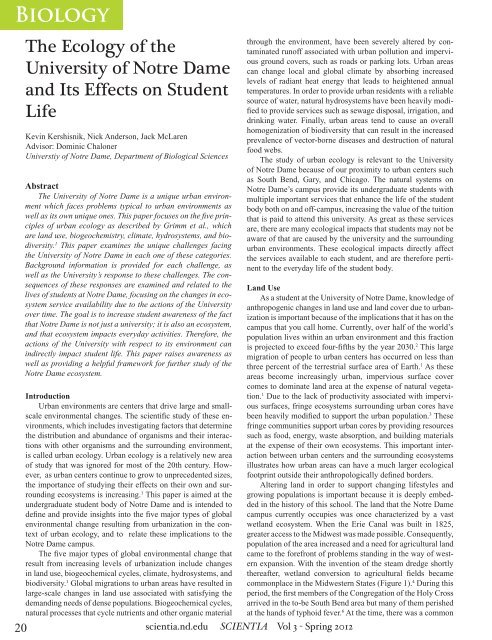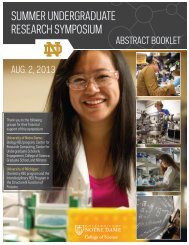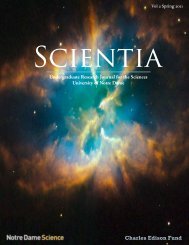Physics - College of Science - University of Notre Dame
Physics - College of Science - University of Notre Dame
Physics - College of Science - University of Notre Dame
Create successful ePaper yourself
Turn your PDF publications into a flip-book with our unique Google optimized e-Paper software.
Biology<br />
20<br />
The Ecology <strong>of</strong> the<br />
<strong>University</strong> <strong>of</strong> <strong>Notre</strong> <strong>Dame</strong><br />
and Its Effects on Student<br />
Life<br />
Kevin Kershisnik, Nick Anderson, Jack McLaren<br />
Advisor: Dominic Chaloner<br />
Universtiy <strong>of</strong> <strong>Notre</strong> <strong>Dame</strong>, Department <strong>of</strong> Biological <strong>Science</strong>s<br />
Abstract<br />
The <strong>University</strong> <strong>of</strong> <strong>Notre</strong> <strong>Dame</strong> is a unique urban environment<br />
which faces problems typical to urban environments as<br />
well as its own unique ones. This paper focuses on the five principles<br />
<strong>of</strong> urban ecology as described by Grimm et al., which<br />
are land use, biogeochemistry, climate, hydrosystems, and biodiversity.<br />
1 This paper examines the unique challenges facing<br />
the <strong>University</strong> <strong>of</strong> <strong>Notre</strong> <strong>Dame</strong> in each one <strong>of</strong> these categories.<br />
Background information is provided for each challenge, as<br />
well as the <strong>University</strong>’s response to these challenges. The consequences<br />
<strong>of</strong> these responses are examined and related to the<br />
lives <strong>of</strong> students at <strong>Notre</strong> <strong>Dame</strong>, focusing on the changes in ecosystem<br />
service availability due to the actions <strong>of</strong> the <strong>University</strong><br />
over time. The goal is to increase student awareness <strong>of</strong> the fact<br />
that <strong>Notre</strong> <strong>Dame</strong> is not just a university; it is also an ecosystem,<br />
and that ecosystem impacts everyday activities. Therefore, the<br />
actions <strong>of</strong> the <strong>University</strong> with respect to its environment can<br />
indirectly impact student life. This paper raises awareness as<br />
well as providing a helpful framework for further study <strong>of</strong> the<br />
<strong>Notre</strong> <strong>Dame</strong> ecosystem.<br />
Introduction<br />
Urban environments are centers that drive large and smallscale<br />
environmental changes. The scientific study <strong>of</strong> these environments,<br />
which includes investigating factors that determine<br />
the distribution and abundance <strong>of</strong> organisms and their interactions<br />
with other organisms and the surrounding environment,<br />
is called urban ecology. Urban ecology is a relatively new area<br />
<strong>of</strong> study that was ignored for most <strong>of</strong> the 20th century. However,<br />
as urban centers continue to grow to unprecedented sizes,<br />
the importance <strong>of</strong> studying their effects on their own and surrounding<br />
ecosystems is increasing. 1 This paper is aimed at the<br />
undergraduate student body <strong>of</strong> <strong>Notre</strong> <strong>Dame</strong> and is intended to<br />
define and provide insights into the five major types <strong>of</strong> global<br />
environmental change resulting from urbanization in the context<br />
<strong>of</strong> urban ecology, and to relate these implications to the<br />
<strong>Notre</strong> <strong>Dame</strong> campus.<br />
The five major types <strong>of</strong> global environmental change that<br />
result from increasing levels <strong>of</strong> urbanization include changes<br />
in land use, biogeochemical cycles, climate, hydrosystems, and<br />
biodiversity. 1 Global migrations to urban areas have resulted in<br />
large-scale changes in land use associated with satisfying the<br />
demanding needs <strong>of</strong> dense populations. Biogeochemical cycles,<br />
natural processes that cycle nutrients and other organic material<br />
through the environment, have been severely altered by contaminated<br />
run<strong>of</strong>f associated with urban pollution and impervious<br />
ground covers, such as roads or parking lots. Urban areas<br />
can change local and global climate by absorbing increased<br />
levels <strong>of</strong> radiant heat energy that leads to heightened annual<br />
temperatures. In order to provide urban residents with a reliable<br />
source <strong>of</strong> water, natural hydrosystems have been heavily modified<br />
to provide services such as sewage disposal, irrigation, and<br />
drinking water. Finally, urban areas tend to cause an overall<br />
homogenization <strong>of</strong> biodiversity that can result in the increased<br />
prevalence <strong>of</strong> vector-borne diseases and destruction <strong>of</strong> natural<br />
food webs.<br />
The study <strong>of</strong> urban ecology is relevant to the <strong>University</strong><br />
<strong>of</strong> <strong>Notre</strong> <strong>Dame</strong> because <strong>of</strong> our proximity to urban centers such<br />
as South Bend, Gary, and Chicago. The natural systems on<br />
<strong>Notre</strong> <strong>Dame</strong>’s campus provide its undergraduate students with<br />
multiple important services that enhance the life <strong>of</strong> the student<br />
body both on and <strong>of</strong>f-campus, increasing the value <strong>of</strong> the tuition<br />
that is paid to attend this university. As great as these services<br />
are, there are many ecological impacts that students may not be<br />
aware <strong>of</strong> that are caused by the university and the surrounding<br />
urban environments. These ecological impacts directly affect<br />
the services available to each student, and are therefore pertinent<br />
to the everyday life <strong>of</strong> the student body.<br />
Land Use<br />
As a student at the <strong>University</strong> <strong>of</strong> <strong>Notre</strong> <strong>Dame</strong>, knowledge <strong>of</strong><br />
anthropogenic changes in land use and land cover due to urbanization<br />
is important because <strong>of</strong> the implications that it has on the<br />
campus that you call home. Currently, over half <strong>of</strong> the world’s<br />
population lives within an urban environment and this fraction<br />
is projected to exceed four-fifths by the year 2030. 2 This large<br />
migration <strong>of</strong> people to urban centers has occurred on less than<br />
three percent <strong>of</strong> the terrestrial surface area <strong>of</strong> Earth. 1 As these<br />
areas become increasingly urban, impervious surface cover<br />
comes to dominate land area at the expense <strong>of</strong> natural vegetation.<br />
1 Due to the lack <strong>of</strong> productivity associated with impervious<br />
surfaces, fringe ecosystems surrounding urban cores have<br />
been heavily modified to support the urban population. 3 These<br />
fringe communities support urban cores by providing resources<br />
such as food, energy, waste absorption, and building materials<br />
at the expense <strong>of</strong> their own ecosystems. This important interaction<br />
between urban centers and the surrounding ecosystems<br />
illustrates how urban areas can have a much larger ecological<br />
footprint outside their anthropologically defined borders.<br />
Altering land in order to support changing lifestyles and<br />
growing populations is important because it is deeply embedded<br />
in the history <strong>of</strong> this school. The land that the <strong>Notre</strong> <strong>Dame</strong><br />
campus currently occupies was once characterized by a vast<br />
wetland ecosystem. When the Erie Canal was built in 1825,<br />
greater access to the Midwest was made possible. Consequently,<br />
population <strong>of</strong> the area increased and a need for agricultural land<br />
came to the forefront <strong>of</strong> problems standing in the way <strong>of</strong> western<br />
expansion. With the invention <strong>of</strong> the steam dredge shortly<br />
thereafter, wetland conversion to agricultural fields became<br />
commonplace in the Midwestern States (Figure 1). 4 During this<br />
period, the first members <strong>of</strong> the Congregation <strong>of</strong> the Holy Cross<br />
arrived in the to-be South Bend area but many <strong>of</strong> them perished<br />
at the hands <strong>of</strong> typhoid fever. 6 At the time, there was a common<br />
scientia.nd.edu SCIENTIA Vol 3 - Spring 2012






